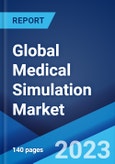Medical simulation refers to the virtual duplication of in-situ activities for training, feedback and experiential learning. It is commonly used by physicians, nurses, surgeons and other practitioners under training to learn, practice and assess their skills in a safe environment. Medical simulation uses body manikins, task trainers and virtual reality (VR)-based systems for laparoscopic, gynecological, cardiovascular, arthroscopic, spinal, endovascular, dental and eye simulation. It provides feedback from observers, such as professors, peers, actor-patients and video cameras, and aids in enhancing patient safety, optimizing communications and improving crisis resource management. As a result, it finds extensive applications across hospitals, academic institutes, military organizations, research facilities and ambulatory care centers.
Medical Simulation Market Trends
Significant growth in the medical industry across the globe is among the key factors creating a positive outlook for the market. Moreover, the increasing awareness regarding the benefits of simulation-based learning among the masses is providing a thrust to the market growth. In line with this, the widespread adoption of laparoscopic simulation systems for effective cancer treatment is also contributing to the market growth. Various technological advancements, such as the integration of augmented reality (AR), robotics and artificial intelligence (AI) solutions in interventional simulators, are acting as other growth-inducing factors. These simulators are extensively used for training physicians in conducting cholecystectomy, appendectomy, gastric bypass, tubal ligation and hysterectomy. Other factors, including the rising concerns regarding patient safety, along with rapid digitization of the healthcare industry, especially in the developing economies, are anticipated to drive the market toward growth.Key Market Segmentation
This research provides an analysis of the key trends in each sub-segment of the global medical simulation market report, along with forecasts at the global, regional and country level from 2023-2028. The report has categorized the market based on product and services, fidelity and end user.Breakup by Product and Services:
- Model-based Simulation
- Surgical Simulation
- Ultrasound Simulation
- Web-based Simulation
- Simulation Training Services
Breakup by Fidelity:
- Low Fidelity
- Medium Fidelity
- High Fidelity
Breakup by End User:
- Hospitals and Clinics
- Academic Institutions and Research Centers
- Military Organizations
Breakup by Region:
- North America
- United States
- Canada
- Asia-Pacific
- China
- Japan
- India
- South Korea
- Australia
- Indonesia
- Europe
- Germany
- France
- United Kingdom
- Italy
- Spain
- Russia
- Latin America
- Brazil
- Mexico
- Middle East and Africa
Competitive Landscape
The competitive landscape of the industry has also been examined along with the profiles of the key players being Cardionics Inc. (3B Scientific GmbH), Gaumard Scientific Company Inc., Kyoto Kagaku Co. Ltd, Laerdal Medical, Mentice, Operative Experience Inc., Simbionix USA Corporation (3D Systems), Simulab Corporation, Surgical Science Sweden AB, Synaptive Medical Inc., SynBone AG and VirtaMed AG.Key Questions Answered in This Report:
- How has the global medical simulation market performed so far and how will it perform in the coming years?
- What has been the impact of COVID-19 on the global medical simulation market?
- What are the key regional markets?
- What is the breakup of the market based on the product and services?
- What is the breakup of the market based on the fidelity?
- What is the breakup of the market based on the end user?
- What are the various stages in the value chain of the industry?
- What are the key driving factors and challenges in the industry?
- What is the structure of the global medical simulation market and who are the key players?
- What is the degree of competition in the industry?
Table of Contents
Companies Mentioned
- Cardionics Inc. (3B Scientific GmbH)
- Gaumard Scientific Company Inc.
- Kyoto Kagaku Co. Ltd
- Laerdal Medical
- Mentice
- Operative Experience Inc.
- Simbionix USA Corporation (3D Systems)
- Simulab Corporation
- Surgical Science Sweden AB
- Synaptive Medical Inc.
- SynBone AG
- VirtaMed AG
Methodology

LOADING...
Table Information
| Report Attribute | Details |
|---|---|
| No. of Pages | 140 |
| Published | November 2023 |
| Forecast Period | 2022 - 2028 |
| Estimated Market Value ( USD | $ 2.2 Billion |
| Forecasted Market Value ( USD | $ 4.7 Billion |
| Compound Annual Growth Rate | 13.5% |
| Regions Covered | Global |
| No. of Companies Mentioned | 12 |









